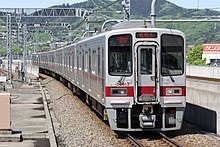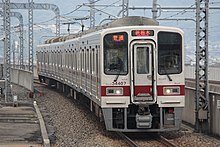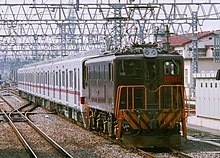Tobu 30000 series
| Tobu 30000 series | |
|---|---|
 30000 series set 31604 in October 2021 | |
| Manufacturer | Alna Kōki, Tokyu Car Corporation, Fuji Heavy Industries |
| Constructed | 1996–2003 |
| Entered service | 1997 |
| Number built | 150 vehicles (30 sets) |
| Number in service | 150 vehicles (16 sets; as of 24 January 2020) |
| Formation | 10/6/4 cars per trainset |
| Operators | Tobu Railway |
| Depots |
|
| Lines served | |
| Specifications | |
| Car body construction | Stainless steel |
| Car length | 20 m (65 ft 7 in) |
| Doors | 4 pairs per side |
| Maximum speed | 120 km/h (75 mph) |
| Traction system | Variable frequency (IGBT) |
| Traction motors | TM-95 three-phase induction motor |
| Power output | 190 kW (250 hp) per motor |
| Acceleration | 3.3 km/(h⋅s) (2.1 mph/s)[a] |
| Deceleration |
|
| Electric system(s) | 1,500 V DC overhead line |
| Current collector(s) | Single-arm pantograph |
| Bogies |
|
| Braking system(s) | Electronically controlled pneumatic brakes with regenerative braking |
| Multiple working | 10000 series |
| Headlight type | High-intensity discharge |
| Track gauge | 1,067 mm (3 ft 6 in) |
| Notes/references | |
| Specification sources:[1][2] | |
The Tobu 30000 series (東武30000系, Tōbu 30000-kei) is a DC electric multiple unit (EMU) commuter train type operated by the private railway operator Tobu Railway in Japan since 1997.[3] Initially formed as six-car and four-car sets, sets are mostly formed as permanently coupled ten-car formations since 2011.
Formations
As of 24 January 2020,[4] the fleet consists of one six-car and one four-car set based at Minami-Kurihashi and Kasukabe depots for Tobu Skytree Line and Tobu Nikko Line services, and 14 permanently coupled 6+4-car sets based at Shinrinkoen Depot for Tobu Tojo Line services.[5]
10-car Tobu Tojo Line sets
| Car No. | 1 | 2 | 3 | 4 | 5 | 6 | 7 | 8 | 9 | 10 |
|---|---|---|---|---|---|---|---|---|---|---|
| Designation | Tc2 | M2A | M1A | T | T | M3 | T1 | M2 | M1 | Tc1 |
| Numbering | 34400 | 33400 | 32400 | 31400 | 36600 | 35600 | 34600 | 33600 | 32600 | 31600 |
- The M1 and M1A cars are each fitted with two single-arm pantographs, and the M3 cars are fitted with one.[5]
- Cars 2, 3, 6, and 9 have wheelchair spaces.[5]
6-car sets

| Designation | Tc1 | M1 | M2 | T1 | M3 | Tc2 |
|---|---|---|---|---|---|---|
| Numbering | 31600 | 32600 | 33600 | 34600 | 35600 | 36600 |
The M1 cars are fitted with two single-arm pantographs, and the M3 cars are fitted with one.[5]
4-car sets

| Designation | Tc1 | M1A | M2A | Tc2 |
|---|---|---|---|---|
| Numbering | 31400 | 32400 | 33400 | 34400 |
The M1A cars are fitted with two single-arm pantographs.[5]
Bogies
- SS038 trailer bogie
- SS138 motored bogie
Interior
Passenger accommodation consists of longitudinal seating throughout.[1]: 43
The first three sets delivered, sets 31601, 31401, and 31402, had flat panels on the seat ends and no centre stanchions. Set 31403 was fitted with contoured seats, and these were fitted on all subsequent sets delivered. Sets 31607 and 31407 onward had higher light blue panels on the seat ends.[3]
- Interior view showing seating style in early sets (car 33405)
- Interior view showing seating style in later sets (car 32612), November 2015
- Priority seating in car 32612, November 2015
- A wheelchair space in car 32612, November 2015
History

The first set, 31601, was delivered in November 1996, with the first trains entering service on 25 March 1997.[3] Initially used primarily on Tobu Isesaki Line services, they were introduced on through-running services to and from the Tokyu Den-en-toshi Line via the Tokyo Metro Hanzomon Line from March 2003,[3] operating in 6+4-car formations.[6] However, as the driving cabs between the two sets led to reduced capacity, which hampered the fleet's ability to cope with the congestion rates of the Hanzomon and Den-en-toshi lines, the 30000 series' usage on these services was reduced in late 2005.[6] They were largely superseded by new 50050 series fixed 10-car sets from 18 March 2006.[7]: 70–71 Sets withdrawn from Hanzomon Line through services were reallocated to services on the Isesaki, Nikko, and Utsunomiya lines.[6]
Transfer to Tojo Line
From January 2011, pairs of four- and six-car sets were transferred to the Tobu Tojo Line, commencing with sets 31601 and 31401.[8] These sets entered revenue service from 13 June 2011 following modifications at Shinrinkōen Depot to form a permanently coupled 10-car set with control equipment and skirts removed from the two intermediate driving cabs.[9] In addition, the electrical couplers from the end cars were removed.[7]: 71
- Permanently coupled sets 31401 and 31601 undergoing driver training on the Tojo Line, April 2011
- Permanently coupled intermediate driving cabs of cars 36610 and 31410, November 2021
Fixed 10-car set conversion dates
| Set No. | Official modification date |
|---|---|
| 31601+31401 | 23 March 2011[10] |
| 31602+31402 | 14 January 2015[5] |
| 31603+31403 | 3 December 2012[11] |
| 31604+31404 | 22 March 2013[11] |
| 31605+31405 | 5 July 2012[11] |
| 31606+31406 | 23 January 2020[4] |
| 31607+31407 | 23 October 2014[5] |
| 31608+31408 | 26 June 2013[12] |
| 31609+31409 | |
| 31610+31410 | 3 October 2012[11] |
| 31611+31411 | 18 November 2011[10] |
| 31612+31412 | 8 July 2014[5] |
| 31613+31413 | 27 January 2014[12] |
| 31614+31414 | 2 September 2014[5] |
| 31615+31415 | 8 October 2013[12] |
Notes
References
- ^ a b c 東京私鉄通勤電車図鑑 [Illustrated book of commuter trains in Tokyo]. Japan Railfan Magazine (in Japanese). Vol. 39, no. 454. Japan: Koyusha Co., Ltd. February 1999. pp. 8–49.
- ^ 新車ガイド 東武鉄道30000系 [New Rolling Stock Guide: Tobu 30000 series]. Japan Railfan Magazine. Vol. 37, no. 430. Japan: Koyusha Co., Ltd. February 1997.
- ^ a b c d 2006東武鉄道通勤車両カタログ [2006 Tobu Railway Commuter Rolling Stock Catalogue]. Tetsudō Daiya Jōhō Magazine. Vol. 35, no. 263. Japan: Kotsu Shimbun. March 2006. pp. 13–15.
- ^ a b 東武30000系31606編成と31406編成が東上線へ [Tobu 30000 series sets 31606 and 31406 transferred to the Tojo Line]. Japan Railfan Magazine Online (in Japanese). Japan: Koyusha Co., Ltd. 24 January 2020. Archived from the original on 26 January 2022. Retrieved 26 January 2022.
- ^ a b c d e f g h i 私鉄車両編成表 2015 [Private Railway Rolling Stock Formations - 2015] (in Japanese). Japan: Kotsu Shimbunsha. 23 July 2015. pp. 40–42, 204. ISBN 978-4-330-58415-7.
- ^ a b c Keiju, Osano (19 September 2021). "東上線でも大活躍、「転勤族」東武30000系の半生" [The double-life of the Tobu 30000 series]. Toyo Keizai Online (in Japanese). Archived from the original on 27 January 2023. Retrieved 6 December 2022.
- ^ a b Hogan, Kishida (March 2012). "The Tobu Railway World". Japan Railfan Magazine (in Japanese). Vol. 52, no. 611. Japan: Koyusha Co., Ltd. pp. 70–75.
- ^ 東武30000系31601編成+31401編成が森林公園検修区へ [Tobu 30000 series sets 31601 and 31401 move to Shinrinkōen Depot]. Japan Railfan Magazine Online (in Japanese). Koyusha Co., Ltd. 27 January 2011. Archived from the original on 29 January 2011. Retrieved 28 January 2011.
- ^ 東武鉄道30000系 東上線で運用開始 [Tobu 30000 series enters service on Tojo Line]. Tetsudō Daiya Jōhō Magazine. Vol. 40, no. 329. Japan: Kōtsū Shimbun. September 2011. p. 73.
- ^ a b 私鉄車両編成表 2012 [Private Railway Rolling Stock Formations - 2012]. Japan: Kotsu Shimbunsha. July 2012. p. 199. ISBN 978-4-330-29911-2.
- ^ a b c d 私鉄車両編成表 2013 [Private Railway Rolling Stock Formations - 2013]. Japan: Kotsu Shimbunsha. 30 July 2013. p. 205. ISBN 978-4-330-39313-1.
- ^ a b c 私鉄車両編成表 2014 [Private Railway Rolling Stock Formations - 2014]. Japan: Kotsu Shimbunsha. 24 July 2014. p. 199. ISBN 978-4-330-48414-3.
Further reading
- 東武鉄道30000系 [Tobu 30000 series]. Railway Journal (364). March 1997.
External links
- Tobu 30000 series (in Japanese)







